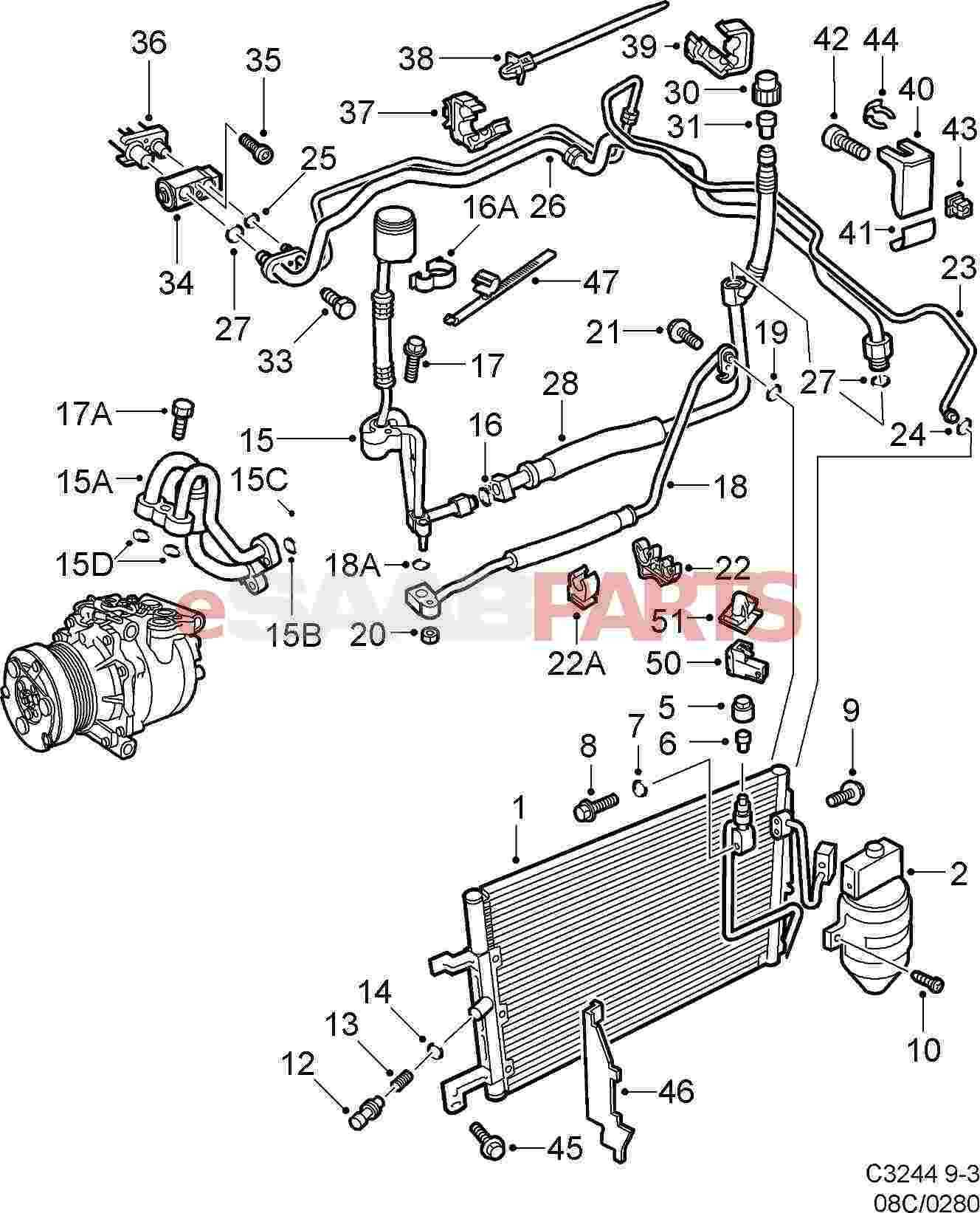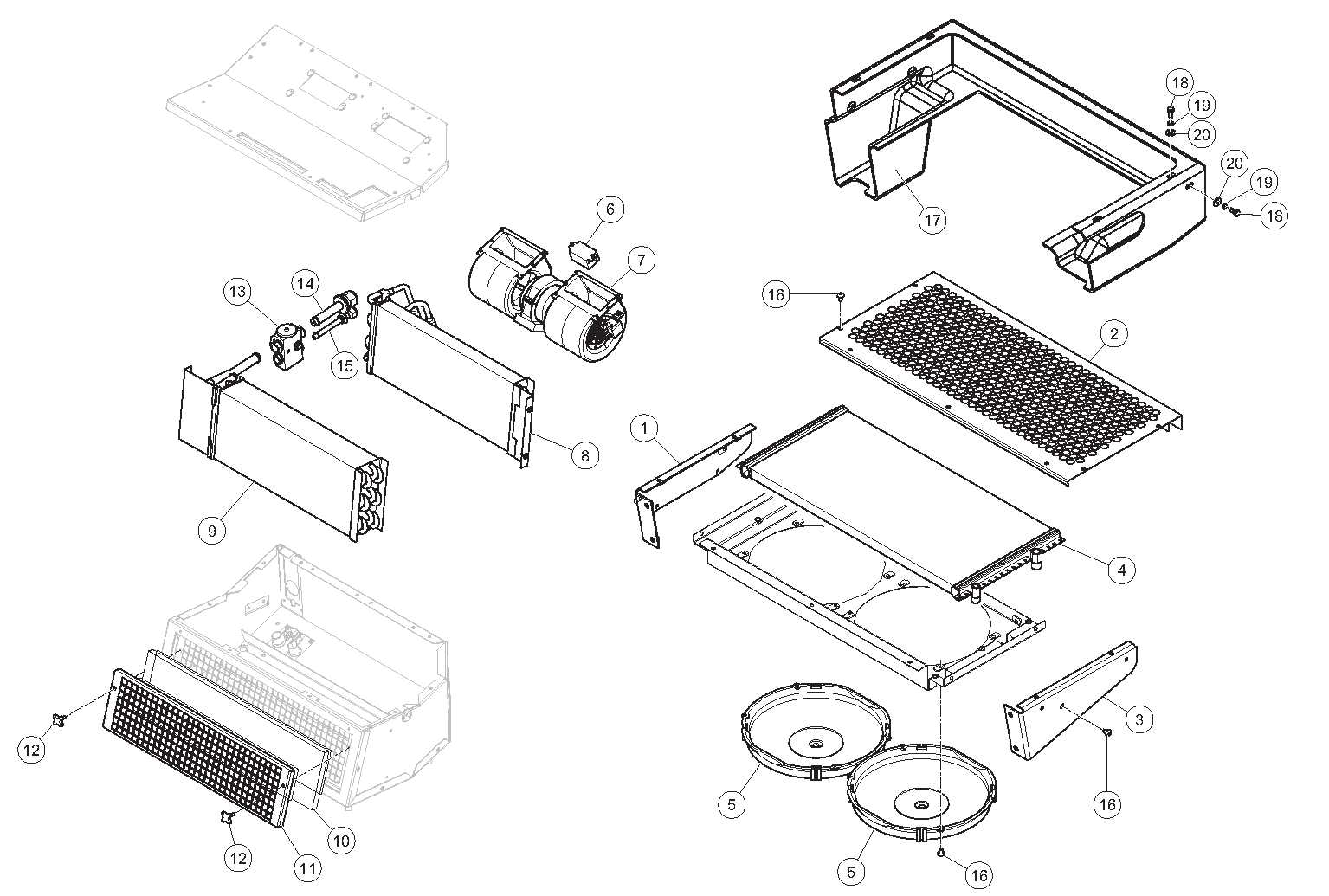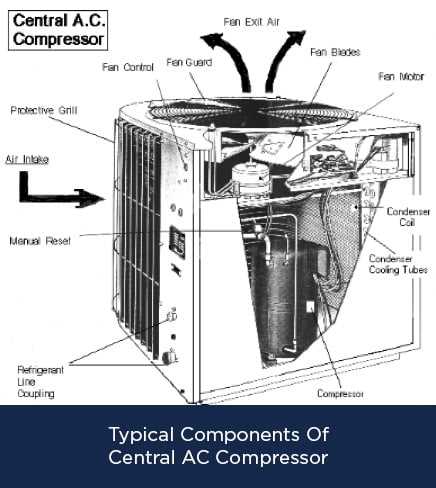Understanding the Components of an AC Unit

Air conditioning systems are essential for maintaining comfort in indoor environments, especially during the warm months. A clear comprehension of the various elements that make up these systems can greatly enhance one’s ability to troubleshoot issues and perform maintenance effectively. Each component plays a crucial role in the overall functionality, working in harmony to deliver cool air and regulate temperature.
Identifying these key elements is vital for anyone looking to improve their knowledge of air conditioning technology. From the cooling mechanism to the control interfaces, recognizing how each section operates contributes to a more efficient system. This understanding not only aids in addressing potential problems but also fosters better decision-making regarding repairs and replacements.
Moreover, a visual representation of the system can be an invaluable tool for learning. It allows individuals to see how the different elements are interconnected, making it easier to grasp their respective functions and importance. As we delve into the details of these essential components, a solid foundation will be established for those interested in maintaining or enhancing their air conditioning experience.
Understanding AC Unit Components
Air conditioning systems comprise several essential elements that work together to ensure efficient cooling and temperature regulation in indoor environments. Familiarity with these components can aid in troubleshooting issues and optimizing performance. This section explores the main features involved in the operation of cooling systems.
Key Elements of Cooling Systems
Compressor: This crucial component acts as the heart of the cooling system. It compresses refrigerant gas, raising its pressure and temperature, which is vital for the heat exchange process.
Evaporator Coil: Located inside, this coil absorbs heat from the indoor air. As air passes over it, the refrigerant inside evaporates, creating a cooling effect that reduces the temperature in the space.
Additional Features for Efficiency
Condenser Coil: Situated outside, this coil releases heat absorbed from the indoor environment. The refrigerant, now in a gas state, dissipates heat to the outdoor air, allowing it to return to a liquid state.
Thermostat: This device regulates the system’s operation by maintaining the desired temperature. It senses the indoor climate and signals the system to start or stop accordingly, ensuring comfort and energy efficiency.
Key Parts of Air Conditioning Systems
Understanding the essential components of cooling systems is crucial for effective maintenance and operation. These systems consist of various elements that work together to provide comfortable indoor temperatures and optimal air quality.
Main Components
- Compressor: This is the heart of the cooling system, responsible for circulating refrigerant and maintaining pressure.
- Condenser: This component dissipates heat absorbed from the indoor air, allowing the refrigerant to cool and condense.
- Evaporator: Here, the refrigerant absorbs heat from the indoor environment, cooling the air before it is circulated back into the room.
- Expansion Valve: This device regulates the flow of refrigerant into the evaporator, ensuring optimal cooling efficiency.
- Air Handler: This part circulates air through the system, distributing cooled air throughout the space.
Additional Elements
- Thermostat: This controls the temperature settings and activates the cooling system as needed.
- Filters: These components trap dust and allergens, promoting cleaner air within the environment.
- Ductwork: This network of passages distributes cooled air from the handler to various rooms.
- Drain Pan: This collects condensation produced during the cooling process, preventing water damage.
How AC Units Operate Efficiently
Understanding the operational principles of cooling systems is essential for maximizing their performance. These systems are designed to regulate indoor temperatures by removing heat and humidity from the air. Effective cooling relies on various components working in harmony to achieve optimal results.
One key factor in achieving efficiency is regular maintenance. Cleaning filters and checking refrigerant levels can significantly enhance performance and energy consumption. Additionally, ensuring proper insulation in the environment helps maintain desired temperatures with minimal effort from the system.
Another aspect involves the use of advanced technologies, such as programmable thermostats, which allow users to set specific temperature schedules. This capability enables the system to operate only when needed, thereby conserving energy and reducing costs. Furthermore, selecting energy-efficient models can lead to substantial savings over time.
In conclusion, enhancing the efficiency of cooling systems involves a combination of routine upkeep, smart technology integration, and careful selection of appliances. By prioritizing these elements, users can enjoy comfortable indoor environments while minimizing their energy footprint.
Common Components in HVAC Units
Heating, ventilation, and air conditioning systems consist of several essential elements that work together to regulate indoor climate. Understanding these components can enhance your knowledge of system functionality and maintenance.
- Compressor: This device circulates refrigerant throughout the system, raising its pressure and temperature.
- Condenser: Here, the refrigerant releases heat and transforms from gas to liquid, allowing for effective heat exchange.
- Evaporator: This component absorbs heat from the indoor environment, cooling the air as refrigerant evaporates.
- Expansion Valve: This valve regulates the flow of refrigerant into the evaporator, ensuring optimal cooling efficiency.
- Fan: The fan circulates air over the evaporator and throughout the living space, promoting comfort.
- Thermostat: This device monitors temperature and controls the operation of the system based on user settings.
Each element plays a vital role in ensuring comfort and efficiency in residential and commercial settings. Understanding their functions can aid in troubleshooting and maintenance practices.
Importance of Each AC Part
The functionality of a cooling system relies on various components working together harmoniously. Each element plays a crucial role in ensuring optimal performance and energy efficiency. Understanding the significance of these elements can help in maintaining the system and enhancing its lifespan.
Compressor is vital as it circulates refrigerant and facilitates heat exchange, making it the heart of the operation. Without it, the entire cooling process would be compromised.
Evaporator coil absorbs heat from the indoor air, allowing the cooling process to take place. Its effectiveness directly impacts the overall comfort level within the space.
Condenser coil releases the absorbed heat outside, playing a key role in the heat exchange cycle. A well-functioning condenser ensures that the system operates efficiently and effectively.
Fan circulates air over the coils, enhancing heat transfer. Proper airflow is essential for maintaining consistent temperatures and comfort in the environment.
Thermostat controls the system’s operation by regulating the temperature. An accurate thermostat helps maintain desired comfort levels while optimizing energy usage.
In summary, every component contributes uniquely to the overall functionality of a cooling system. Recognizing their importance fosters better maintenance practices and encourages informed decisions when it comes to repairs or upgrades.
Identifying AC Unit Functionality
Understanding the various components of an air conditioning system is essential for effective troubleshooting and maintenance. Each element plays a crucial role in ensuring the overall efficiency and comfort of your indoor environment. Recognizing how these components work together allows for informed decision-making when it comes to repairs or upgrades.
Key Components and Their Roles

Compressor: The heart of the system, this device circulates refrigerant throughout the entire system, playing a vital role in heat exchange.
Evaporator Coil: This component absorbs heat from the indoor air, facilitating the cooling process as the refrigerant evaporates.
Maintenance and Performance
Regular maintenance of these elements is crucial to ensure optimal functionality. Keeping the system clean and free from debris can enhance performance and extend the lifespan of the equipment. Monitoring the operation of each component helps identify potential issues before they escalate, promoting a comfortable living space.
Maintenance Tips for AC Components
Proper care of air conditioning elements is essential for optimal performance and longevity. Regular attention to these components ensures efficient cooling and reduces the likelihood of breakdowns. Here are some essential maintenance tips to keep your cooling system running smoothly.
Regular Cleaning
Dust and debris can accumulate in the various components, hindering airflow and efficiency. Ensure that the filters are cleaned or replaced frequently. Additionally, wipe down accessible surfaces to maintain cleanliness.
Check Refrigerant Levels
Monitoring refrigerant levels is crucial for effective operation. Low levels can lead to inadequate cooling and increased energy consumption. If you suspect a leak, contact a professional to assess and refill as needed.
Inspect Electrical Connections

Loose or damaged electrical connections can pose safety risks and affect functionality. Regularly check wiring and connections for any signs of wear or corrosion, and address issues promptly.
| Tip | Frequency |
|---|---|
| Clean or replace filters | Monthly |
| Check refrigerant levels | Seasonally |
| Inspect electrical connections | Annually |
Diagram of Air Conditioning Parts
An air conditioning system consists of various components that work together to provide efficient cooling. Understanding the layout and function of each element can greatly enhance the maintenance and troubleshooting processes. This overview will explore the essential elements that contribute to the effective operation of these cooling systems.
| Component | Function |
|---|---|
| Compressor | Pumps refrigerant through the system, increasing pressure and temperature. |
| Condenser Coil | Releases heat from the refrigerant, allowing it to condense into a liquid. |
| Evaporator Coil | Absorbs heat from the indoor air, cooling it before circulating back into the space. |
| Expansion Valve | Regulates the flow of refrigerant into the evaporator coil. |
| Air Handler | Distributes cooled air throughout the indoor environment. |
| Thermostat | Controls the temperature setting and activates the cooling system when needed. |
Signs of AC Component Failure
Identifying issues within an air conditioning system is crucial for maintaining its efficiency and longevity. Various indicators can signal that specific elements are not functioning correctly. Recognizing these signs early can prevent further damage and costly repairs.
Unusual Noises: If you hear strange sounds such as grinding, squealing, or hissing, it may suggest that mechanical parts are worn out or damaged. These noises often indicate that a component requires immediate attention.
Inconsistent Cooling: An air conditioning system that fails to maintain a consistent temperature can be a sign of malfunctioning components. This inconsistency might manifest as uneven cooling in different rooms or fluctuating temperature settings.
Increased Energy Bills: A sudden spike in energy costs could indicate that the system is struggling to operate efficiently due to component failure. When certain parts fail, the system may consume more energy to achieve the desired cooling effect.
Leaking Refrigerant: If you notice a refrigerant leak, it can severely impact cooling performance. Low refrigerant levels due to leaks can indicate issues with specific components that need urgent repair or replacement.
Frequent Cycling: If the air conditioning system frequently turns on and off, this short cycling can be a symptom of a failing component. This behavior can lead to increased wear and tear, impacting the overall lifespan of the system.
Replacing AC Parts: A Guide
Maintaining optimal performance of your cooling system often involves substituting certain components. This process can enhance efficiency and prolong the lifespan of the equipment. Understanding the essentials of replacement can empower users to tackle these tasks effectively.
Identify the Necessary Components: Before starting, it is crucial to recognize which elements require attention. Regular maintenance checks can help pinpoint issues that may necessitate replacement. Look for signs of wear, such as unusual noises or decreased cooling efficiency.
Gather Required Tools: Ensuring you have the right tools at hand is vital for a smooth replacement process. Basic tools may include screwdrivers, wrenches, and pliers. Depending on the complexity of the task, additional equipment might be necessary.
Follow Safety Protocols: Always prioritize safety when handling electrical appliances. Disconnect power sources before beginning any maintenance work. Use gloves and goggles to protect yourself from potential hazards.
Execute the Replacement: Once you have identified the faulty component and gathered your tools, proceed with caution. Follow the manufacturer’s guidelines for removal and installation to ensure everything is done correctly. This will help avoid any damage to the system.
Test the System: After completing the replacement, reconnect the power and test the system. Monitor its performance to confirm that the new component functions as expected. If issues persist, consider consulting a professional for further assistance.
Upgrading Your Air Conditioning System
Enhancing your cooling system can significantly improve comfort and efficiency in your living space. With advancements in technology, modern systems offer better performance, reduced energy consumption, and improved air quality. This section will explore various aspects to consider when modernizing your setup.
Key benefits of upgrading include:
- Increased energy efficiency, leading to lower utility bills
- Improved cooling capacity, providing consistent temperatures
- Enhanced air filtration, ensuring better indoor air quality
- Quieter operation, reducing noise levels in your home
Before proceeding with an upgrade, consider the following factors:
- System Size: Ensure the new system is appropriately sized for your space.
- Energy Ratings: Look for systems with high SEER (Seasonal Energy Efficiency Ratio) ratings.
- Installation Options: Evaluate whether you need a complete replacement or just specific enhancements.
- Budget: Establish a realistic budget that accounts for equipment and installation costs.
Consulting with a professional can provide valuable insights and help tailor the best solution for your specific needs.